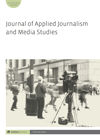
Full text loading...
Through an online experiment, this study examines the impact of live-blogging on audiences’ perception of readability, selective scanning, news credibility, news use and paying intent (N = 220). Contrary to industry expectation, this study found that the quest for speed at the expense of errors (and subsequent corrections) has no effect on the outcome variables, except news presented in the live-blogging format decreases readability. In contrast, news interest predicts all outcome measures. Findings from this study carry theoretical and practical implications for online news production and consumption.

Article metrics loading...

Full text loading...
References


Data & Media loading...

Publication Date:
https://doi.org/10.1386/ajms_00036_1 Published content will be available immediately after check-out or when it is released in case of a pre-order. Please make sure to be logged in to see all available purchase options.